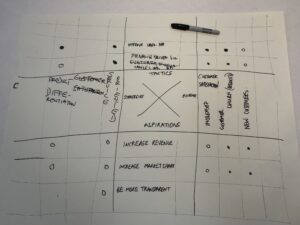In my recent post The Ultimate X-Matrix For Your Agile Transformation I asked people to share how they have used it. In response, Elisabeth Keuschnigg posted her experience on LinkedIn. A lot of what Elisabeth wrote resonated with me and it got me thinking. What are the most important learnings I have had over the many years of using the X-Matrix?
Here are the top five I came up with:
1. It doesn’t have to be explicit
I’ll often use the TASTE model implicitly. On its own, I find it a great way of exploring a context and understanding the dynamics of a transformation. I’ve found that forcing an X-Matrix on people when they’re not ready for it will negate its impact. They need to be ready to have that conversation. Only when I’m comfortable that people are willing to explore and collaborate with the X-Matrix will I introduce it. When that time comes, it then becomes very easy to start fleshing out and filling in an X-Matrix and discussing the various elements and coherence.
2. The more collaboration the better
As a general rule, the more people involved in creating an X-Matrix, the better. I will occasionally sit down with someone and flesh one out individually. However, there is always the risk that the output is taken and distributed as a finished document. Instead, in those situations, I want to use that output as input into a larger conversation. The goal then is to get feedback, a wider perspective, and increased diversity of thought. It’s this collaboration that creates “the memory of what was said and felt that creates alignment, not the final piece of paper”, to quote Thomas L Jackson in Hoshin Kanri for the Lean Enterprise.
3. Perfect is the enemy of the good
I don’t think I’ve ever created an X-Matrix which felt perfect. There are always small tweaks and changes that could be made to the language used. Often there are even multiple plausible variants that could work. The risk of collaborating with too many people (see above) is that it becomes harder to agree on the final version. In this case, it’s OK to have someone (or a smaller group) make the final decision. To repeat the above quote again, it’s “the memory of what was said and felt that creates alignment, not the final piece of paper”. Perfection of the final piece of paper is thus less important.
4. Its a trajectory and not a target
One of the risks with the X-Matrix is that it gets used to set targets and define end states and final solutions. That’s one of the reasons why I included True North in TASTE. We use True North (or the North Star) to set our direction, but it is not our destination. It’s also why I chose to use the terms Aspirations and Evidence instead of alternatives such as Results or Measures. It can be useful to include some numeric detail for the Aspirations to indicate the size of the ambition. However, I generally prefer to describe those things in relative terms such as increasing or decreasing.
5. You do actually need a strategy
This might seem obvious, but the thing I’ve realised most from using the X-Matrix is that most organisations have no idea what their strategy is. Or those that do have a strategy have what Richard Rumelt would define as Bad Strategy; the failure to face the challenge, mistaking goals for strategy, bad strategic objectives, or fluff. And even when there might be a strategy in place, it’s rarely communicated well. Instead, it is just pushed down the organisation as projects and plans, losing the original intent in the process. Of course, this is where the X-Matrix can be most powerful, helping to identify a good strategy, align people to it, and share the whole context with a wider audience.

